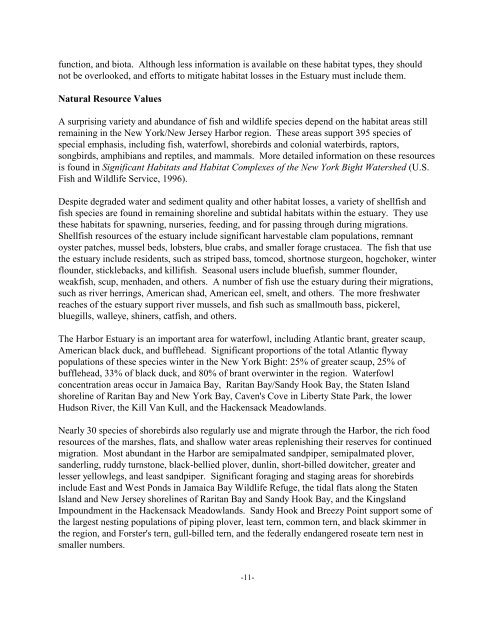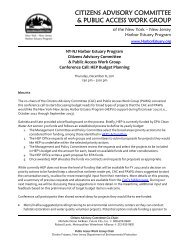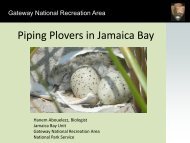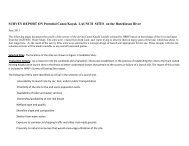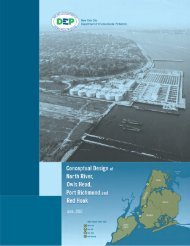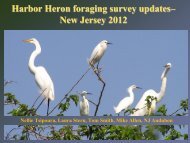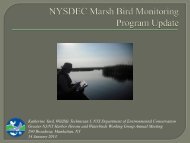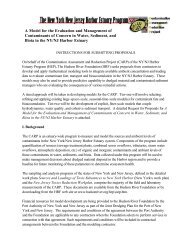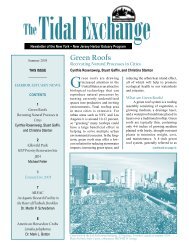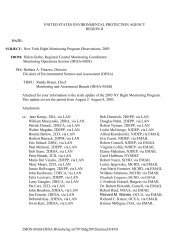DraftMitigation .pdf - New York-New Jersey Harbor Estuary Program
DraftMitigation .pdf - New York-New Jersey Harbor Estuary Program
DraftMitigation .pdf - New York-New Jersey Harbor Estuary Program
You also want an ePaper? Increase the reach of your titles
YUMPU automatically turns print PDFs into web optimized ePapers that Google loves.
function, and biota. Although less information is available on these habitat types, they should<br />
not be overlooked, and efforts to mitigate habitat losses in the <strong>Estuary</strong> must include them.<br />
Natural Resource Values<br />
A surprising variety and abundance of fish and wildlife species depend on the habitat areas still<br />
remaining in the <strong>New</strong> <strong>York</strong>/<strong>New</strong> <strong>Jersey</strong> <strong>Harbor</strong> region. These areas support 395 species of<br />
special emphasis, including fish, waterfowl, shorebirds and colonial waterbirds, raptors,<br />
songbirds, amphibians and reptiles, and mammals. More detailed information on these resources<br />
is found in Significant Habitats and Habitat Complexes of the <strong>New</strong> <strong>York</strong> Bight Watershed (U.S.<br />
Fish and Wildlife Service, 1996).<br />
Despite degraded water and sediment quality and other habitat losses, a variety of shellfish and<br />
fish species are found in remaining shoreline and subtidal habitats within the estuary. They use<br />
these habitats for spawning, nurseries, feeding, and for passing through during migrations.<br />
Shellfish resources of the estuary include significant harvestable clam populations, remnant<br />
oyster patches, mussel beds, lobsters, blue crabs, and smaller forage crustacea. The fish that use<br />
the estuary include residents, such as striped bass, tomcod, shortnose sturgeon, hogchoker, winter<br />
flounder, sticklebacks, and killifish. Seasonal users include bluefish, summer flounder,<br />
weakfish, scup, menhaden, and others. A number of fish use the estuary during their migrations,<br />
such as river herrings, American shad, American eel, smelt, and others. The more freshwater<br />
reaches of the estuary support river mussels, and fish such as smallmouth bass, pickerel,<br />
bluegills, walleye, shiners, catfish, and others.<br />
The <strong>Harbor</strong> <strong>Estuary</strong> is an important area for waterfowl, including Atlantic brant, greater scaup,<br />
American black duck, and bufflehead. Significant proportions of the total Atlantic flyway<br />
populations of these species winter in the <strong>New</strong> <strong>York</strong> Bight: 25% of greater scaup, 25% of<br />
bufflehead, 33% of black duck, and 80% of brant overwinter in the region. Waterfowl<br />
concentration areas occur in Jamaica Bay, Raritan Bay/Sandy Hook Bay, the Staten Island<br />
shoreline of Raritan Bay and <strong>New</strong> <strong>York</strong> Bay, Caven's Cove in Liberty State Park, the lower<br />
Hudson River, the Kill Van Kull, and the Hackensack Meadowlands.<br />
Nearly 30 species of shorebirds also regularly use and migrate through the <strong>Harbor</strong>, the rich food<br />
resources of the marshes, flats, and shallow water areas replenishing their reserves for continued<br />
migration. Most abundant in the <strong>Harbor</strong> are semipalmated sandpiper, semipalmated plover,<br />
sanderling, ruddy turnstone, black-bellied plover, dunlin, short-billed dowitcher, greater and<br />
lesser yellowlegs, and least sandpiper. Significant foraging and staging areas for shorebirds<br />
include East and West Ponds in Jamaica Bay Wildlife Refuge, the tidal flats along the Staten<br />
Island and <strong>New</strong> <strong>Jersey</strong> shorelines of Raritan Bay and Sandy Hook Bay, and the Kingsland<br />
Impoundment in the Hackensack Meadowlands. Sandy Hook and Breezy Point support some of<br />
the largest nesting populations of piping plover, least tern, common tern, and black skimmer in<br />
the region, and Forster's tern, gull-billed tern, and the federally endangered roseate tern nest in<br />
smaller numbers.<br />
-11-


